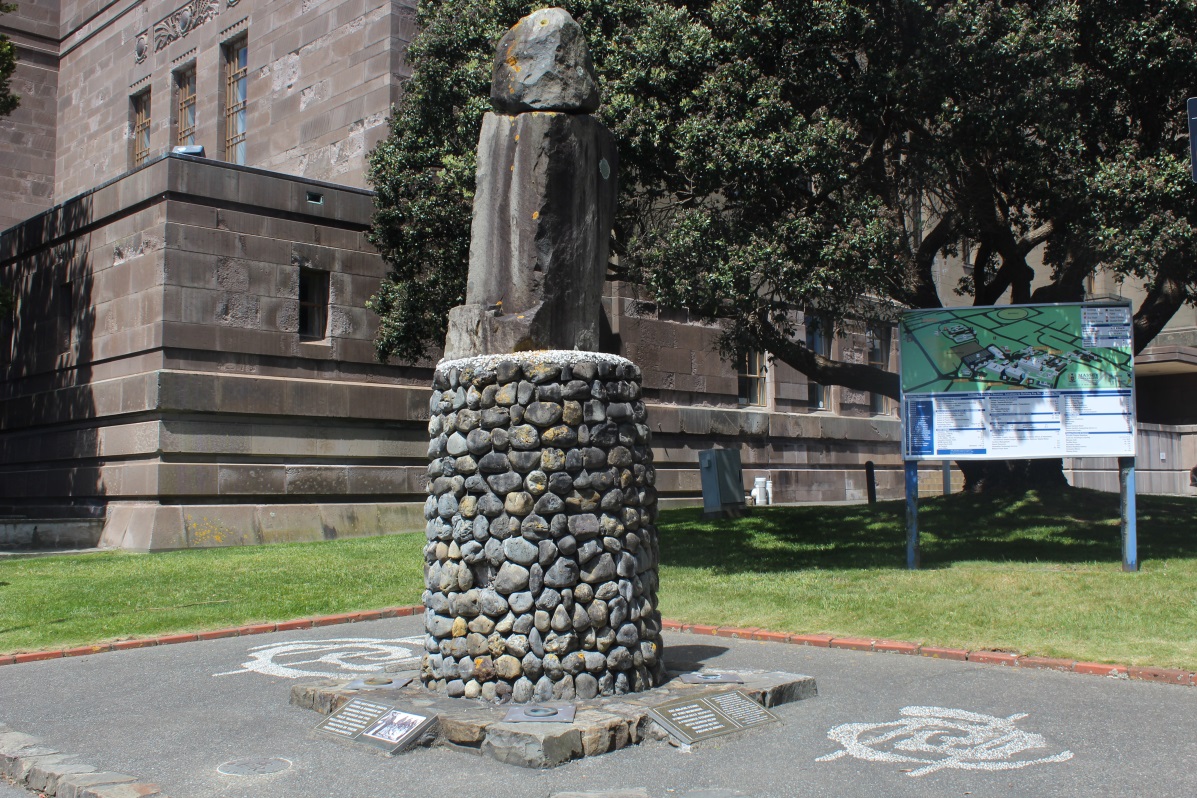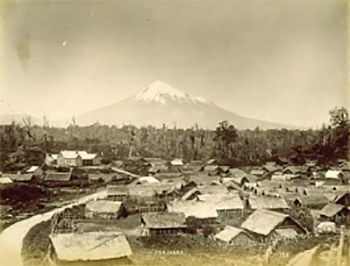The place I have measured out shall remain sacred for my people… I tell the assembled tribes that they shall not be lost.” – Te Whiti-o-Rongomai [1]
A kuia once showed me a piece of pounamu wrapped up underneath black netting. The opulence of the stone was obvious, but it was partially obscured by its binding. She told me that the stone represents Parihaka. The 19th century Parihaka story is one of New Zealand’s most important historical narratives, yet it is still under-recognised. Parihaka today is one of the most important communities in New Zealand, so it is crucial to become aware of its ongoing contributions, ambitions and significance.
The story of Parihaka is centred in Taranaki, but the struggles and trials of its people covered much of the length of the country. In this blog post we will focus on the places in Wellington entwined with the history of the people of Parihaka, and take a look at the ways Wellingtonians can recognise and remember Parihaka this year.

During the 1860s, the prophets Te Whiti and Tohu rose to national prominence among Māori. They were recognised as “the two birds of knowledge” by King Tawhiao. [2] Their community at Parihaka became a haven for Māori, and a place of peaceful resistance to unlawful land confiscation and encroaching settlement. One of those that found their home at Parihaka was Titokowaru, the great military leader of the Māori forces in the Taranaki War of 1868 – 1869. Titokowaru laid down his gun, and took up the plough and the raukura (albatross feather, symbol of peace).
Te Whiti, Tohu, and also Titokowaru led a peaceful campaign of resistance that consisted of ploughing up confiscated land, removing surveying pegs and placing fencing. In response, the government arrested the successive waves of protestors. On 5 November 1881, Parihaka was invaded by a military force of 1600 armed constabulary. Those Māori who were not originally from the Parihaka area were scattered, the buildings were damaged, violence was inflicted against the people and their leaders were arrested. Te Whiti and Tohu were held without trial for two years, before returning home in 1883.
The community Te Whiti and Tohu nurtured still thrives today. It is a place for reconciliation. It is a place to contemplate where we have been and where we are going. Recently, in 2016, the Mayor of New Plymouth, Andrew Judd, led a hikoi walk of peace from New Plymouth to Parihaka.[3]

Prisoners in Mt. Cook
In 1879, 195 arrested ploughmen were held in the Mt. Cook Police Barracks. The peaceful protesters were never tried. Instead, they were shipped to the South Island, to take them further away from the influence of Te Whiti. Government legislation enabled indefinite detainment without trial or punishment. But, ploughmen were put to work on infrastructure in the South Island.[4]
The Prophet in Wellington
In the mid-1880s, there was discontent among coastal Māori, around policy on land the government leased from them. They were especially concerned with the large surveying costs that were deducted from the rent due to them.[5] Māori also desired the return of the lands unlawfully confiscated from them.[6]
In 1886, Te Whiti sent men to plough some of the confiscated land. In response, the government arrested Te Whiti and other leaders. After trial in New Plymouth, Te Whiti, Titokowaru and eight others were sent to Wellington aboard the Hinemoa.[7] Te Whiti was held in the Terrace Gaol for two and a half months before his Supreme Court trial.[8] Te Whiti appeared before Chief Justice Sir James Prendergast, the same Chief Justice who called the Treaty of Waitangi a “simple nullity” in 1877.[9] Te Whiti maintained that he had merely entered onto his own land.
Te Whiti was sentenced to three months’ imprisonment and fined £100.[10] While in prison, Te Whiti was frequently visited by Taare Waitara, a rich Atiawa part-European landowner from Wellington. Waitara married Te Whiti’s daughter and helped develop Parihaka with his finances.[11] Te Whiti’s return journey to Parihaka was “leisurely” and “royal” as he passed through Waikanae , Otaki and Whanganui.[12]
Te Whiti remained an advocate for Māori land rights and peace until his death in 1907.

A Place to Remember
At Pukeahu War Memorial Park, on the north-west corner of the old Dominion Museum building, there is a memorial dedicated to the people of Taranaki and Parihaka who were imprisoned in the Mount Cook barracks. The memorial represents a prisoner wrapped up in a blanket. The base of the monument is formed of stones from Taranaki. As you wander through the city, this is the perfect spot to take a moment to reflect on the Parihaka history of struggle and on the legacy of peace.
Event:
Monday 5 November, 6:00 – 7:20 pm (doors open 5.30 pm)
National Library of New Zealand, Corner Molesworth and Aitken Streets, Thorndon, Wellington
Join Taranaki kaumātua and Treaty negotiator Hon. Mahara Okeroa (Taranaki, Te Ātiawa) and Dr. Rachel Buchanan (Taranaki, Te Ātiawa), author of BWB Text Ko Taranaki Te Maunga, at the National Library for the anniversary of te pāhuatanga, the invasion of Parihaka.
Recommended Reading:
Ko Taranaki te maunga by Rachel Buchanan
Ask that Mountain: the story of Parihaka by Dick Scott
Te Whiti O Rongomai and the Resistance of Parihaka by Danny Keenan
Parihaka : The Art of Passive Resistance
[1] G. W. Rusden History of New Zealand (Melville, Mullen and Slade: 1895), p.218. quoted in Bernard Gadd, ‘The Teachings of Te Whiti O Rongomai, 1831-1907,’ The Journal of the Polynesian Society Volume 75 (1966).
[2] Hikoi Ki Te Waipounamu (2000), p.8.
[3] Deena Coster, ‘Peace Hikoi to Parihaka Presents New Possibilities for Partnership between Maori and Pakeha,’ Stuff (2016) https://www.stuff.co.nz/taranaki-daily-news/80694456/peace-hikoi-to-parihaka-presents-new-possibilities-for-partnership-between-maori-and-pakeha
[4] Parihaka Memorial, (Manatū Taonga Ministry for Culture and Herritage, 2015) https://mch.govt.nz/pukeahu/park/significant-sites/parihaka-memorial
[5] Danny Keenan, Te Whiti O Rongomai and the Resistance of Parihaka (Huia Publishers, 2015), pp.220-224.
[6] Danny Keenan, Te Whiti, p.224.
[7] Dick Scott, Ask That Mountain: The Story of Parihaka, pp.152-153.
[8] Danny Keenan, Te Whiti, pp.224-225.
[9] ‘Chief Justice declares treaty “worthless” and a “simple nullity” (Ministry for Culture and Heritage, 2018) https://nzhistory.govt.nz/the-chief-justice-declares-that-the-treaty-of-waitangi-is-worthless-and-a-simple-nullity
[10] Dick Scott, Ask That Mountain, p.153.
[11] Dick Scott, Ask That Mountain, p.153.
[12] Dick Scott, Ask That Mountain, p.153.


